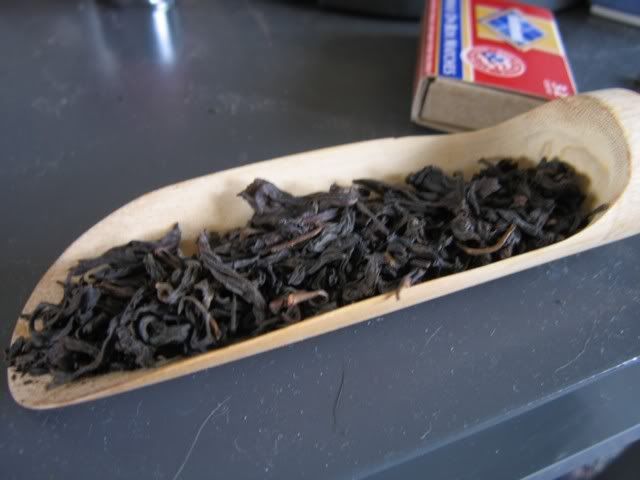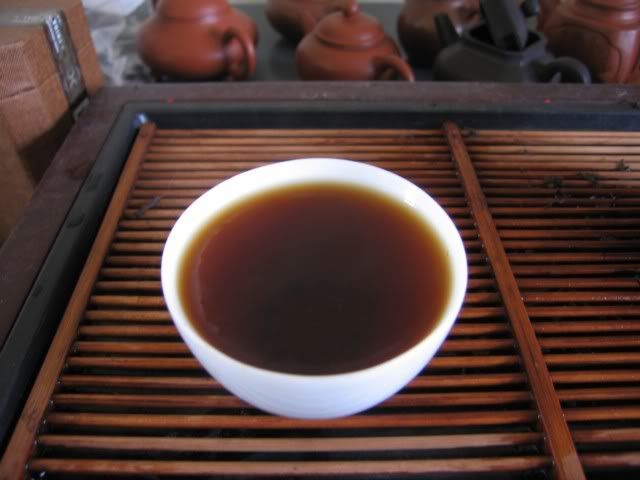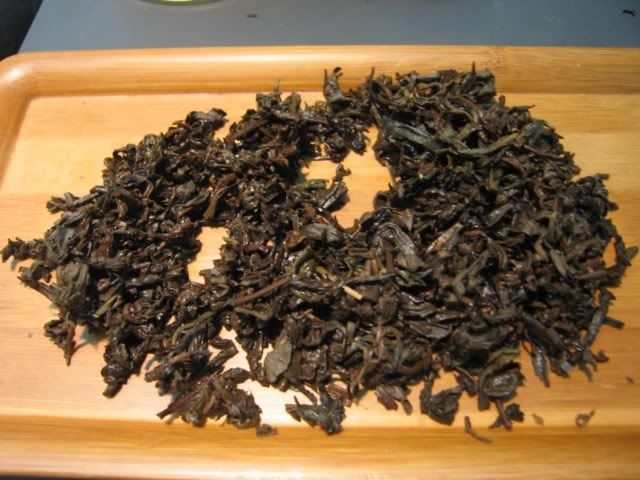Who said tea’s not as strong as coffee?
Today I made this

As is usually the case, I overdosed myself because this is the remainder of the bag — the awkward amount that is a little much for one pot, but not enough for two. I threw it all in. Water goes in one end, tea comes out the other…

The tea came out very thick and strong. It was punchy. This tea is usually quite delicate, with lots of good plummy notes. Today it bulldozed over me with a strong, strong note of roasted baozhong, even though when brewed normally, there isn’t any roasted notes left. It didn’t help, of course, that bottom of the bag means lots of fannings that have been sinking to the bottom since I first got this tea. I was getting a headache drinking this thing.
The best infusion was probably the 10th, or was it the 12th? Nice plum notes, still quite strong. Whoever says coffee is stronger should try making teas like this. I remember once I was treated to the “VIP method” by Rosa of Best Tea House. “VIP method” means using a small Yixing pot, fill it up with Chaozhou gongfu heavily roasted oolong (when I say fill it up I mean fill it up…) and then brewing it with one drinking cup worth of water. The liquor that comes out is almost sticky. The tea is strong, and it knocks you right out. Quite a ride.
I could probably drink this again tomorrow, but I think I should go easy on myself with something simple and easy going. This was a little much…


 RSS - Posts
RSS - Posts
8 responses so far ↓
vlad_l // February 12, 2008 at 6:38 am |
In my experience there is always a certain concentration above which coffee doesn’t venture under normal atmospheric pressure, alas (or not?) the same is not true for tea. Oh and the array of pots in the background is a little scary 🙂
Just curious, was the leaf quite soft or brittle?
-vl.
mulcahyfeldman // February 12, 2008 at 9:48 am |
Actually the array of pots is quite beautiful. Can you point out which pot is used for what tea? I’ve read that some restrict a pot to one variety of tea which would require a number of pots for some people. This aged baozhong sounds very interesting. Is it available anywhere? Do you remember where you acquired it from? How long did you store it? Sorry for so many questions… Eileen
MANDARINstea // February 12, 2008 at 10:08 am |
This will be a great tea to brew overnight, after the 8th brewing. How old is this? Looks like a 8-15 years old…. Consuming it cold might give you a very different dimension.
I guess the 1 to 1 style is better on Anxi TGY then other oolong, hmmm make me want to get myself a shot : ) Tok
MarshalN // February 12, 2008 at 10:09 am |
I don’t know, VL, since I don’t drink coffee much 🙂
The leaf — you mean dry or wet?
Eileen: Well, the black one and the one next to it I use for aged oolongs, and the shuiping (the only other pot where the lid is visible) is for my young puerh. I’ve recently started thinking that it really doesn’t matter much whether or not you devote a pot to one type of tea, although I’m still experimenting with that. Since I am not drinking much else these days though, it’s a bit of a problem.
This baozhong is around 20 years old, I think, and I got it in Taiwan. Me? I only stored it for a few months. It’s a drink it now for me, although I did buy more than 1.5kg so that I know I won’t run out anytime soon.
Anonymous // February 12, 2008 at 6:28 pm |
@mulcahyfeldman – nice ID photo ..
mulcahyfeldman // February 13, 2008 at 4:39 pm |
Could you explain the term “shuiping”? Thanks, Eileen
Anonymous // February 14, 2008 at 11:58 am |
“a little much for one pot, but not enough for two. I threw it all in. Water goes in one end, tea comes out the other…’
LOL That’s the spirit!
Samcha
mulcahyfeldman // February 15, 2008 at 9:26 am |
Thanks, I’ve been looking (but perhaps in all the wrong places) and can’t find a single reference to shuiping that makes sense in a tea sense.